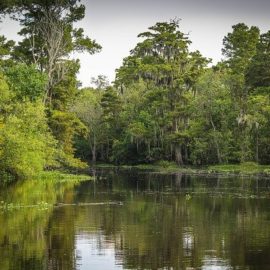
Louisiana population has moved below I-10 and the largest growth is in this area, specifically Jefferson Parish.
It was the end of another grueling day of gardening and landscaping. Walter Cruz trudged into his Kenner apartment, headed for his dining room table, and reached for a maple syrup caddy holding an Aleve bottle. This is always my first stop when I get back,” Cruz said. He takes the pain reliever after each workday, which can last up to 14 hours, six or seven days a week. “Sometimes I feel like I’m dead because it’s so tiring,” he said, “but it puts money in my pocket and lets me cover our necessities, and to us, that’s indispensable.” Cruz and his wife of 34 years, Mirna, have lived in Kenner since immigrating to the U.S. from their native Guatemala in early 2016. They feel fortunate they were able to get permanent residency — “green cards” — with the help of Cruz’s sister. But settling here was one of the most difficult decisions the Cruzes, both 54, have had to make. They could only make the move with the youngest of their three boys, who was just shy of 20. The others — in their mid-20s — were deemed too old, the couple recalled. “It’s like tearing off a piece of your body,” Cruz said. “And then, once you do it, how do you get it back on?”
nola.com
Living in New Orleans we largely do not see these stories as we see workers but they do not live here.
Making a steady living in Guatemala was dicey. The Cruzes said they farmed tomatoes on their property, raised pigs and other livestock, and trucked various goods. Some months the work was plentiful. But other times, the trucks would sit idle for months as entire tomato harvests went to waste. So they made the move. And now, they’ve put down roots, with Walter running his landscaping business, Mirna cleaning houses part-time, and their son traveling across the country pulling industrial and commercial wires. “As long as it keeps raining and there’s grass to cut and it’s not too cold to plant, we’ll be here,” Cruz said.
We saw similar growth in Virginia but more with El Salvadorans and Hondurans. One in one county and the other in the neighboring one. The build by by country started when the first few came to the area. Others joined their countrymen. I saw a lot in the high school math classes I taught, as well as students from around the world as we lived in Northern Virginia.
Stories like the Cruzes’ have played out across Louisiana in steadily increasing numbers over the last two decades, which has seen the state’s Hispanic community grow at an unprecedented rate. As of the 2020 census, there are now 322,500 Hispanic Louisianans. That’s more than the number of people who live in St. Tammany Parish. Still, at just 6%, Louisiana’s share of Latinos lags well behind the national share of nearly 20%. But the state’s Hispanic population has grown even as the number of non-Hispanic Louisianans has stagnated or declined. The growth owes largely to an influx of construction workers following Hurricane Katrina in 2005 and a spate of other disasters since. Louisiana’s Latino community gained more members in the past 20 years than that of any other racial or ethnic group, accounting for basically all of the state’s growth. Nearly 85,000 Hispanic people moved to Louisiana between 2000 and 2010; without them, the state would have shrunk by about 20,000 people. Over the past 10 years, Louisiana experienced an increase of nearly 130,000 Hispanic residents — more than the state’s overall gain in population.
Without them the population would have shrunk and a lot of jobs would not have been filled. Especially in Jefferson Parish.
The epicenter of that growth has been Jefferson Parish — Kenner, in particular, possibly because of a glut of affordable housing, along with it having the reputation as a place where prior waves of Hispanic immigrants had established themselves. More than 79,000 Hispanic people now live in the suburban parish, with roughly a quarter living in or around Kenner, home to New Orleans’ international airport. The community now accounts for about 18% of the parish’s total population. To give a sense of scale: Jefferson gained about 25,400 Hispanic residents since 2010. That’s a bigger jump in Hispanic people in a single decade than any other parish in the state has experienced in the last two decades. The Jefferson Parish Public School System’s enrollment of Hispanic students underscores the steep rise. In just the last eight years, the state’s largest school district has seen the share of its students who identify as Hispanic jump from 20% to 34%. All of that has left nearly a third of the district’s 81 campuses with majority Hispanic enrollment. Two Jefferson schools — Terrytown Elementary on the West Bank and Green Park Elementary in Metairie — have Hispanic student populations of more than 70%, an astounding benchmark that would once have seemed incomprehensible. As Cruz put it: “We feel, if not at home, that we’re somewhere familiar, and it’s nice.”
The early fruit trade started the influx. It has grown.
The tropical fruit trade of the early to mid-20th century planted the seeds of the New Orleans area’s booming Hispanic population. Many older Hondurans and people from other Central American countries came here because of that industry, and they’ve gone on to have children and grandchildren. But it’s been more than a half-century since that industry drove local immigration patterns, said Tulane University geographer Richard Campanella. More recently, Hispanic newcomers have been drawn by the wealth of job opportunities in debris removal, roofing and home construction following Katrina, the 2016 floods around Baton Rouge, and the devastation wrought by Laura, Delta, Ida and Zeta during the hellacious hurricane seasons of 2020 and 2021, according to Campanella and Allison Plyer, the Data Center’s chief demographer. In the wake of those two broad patterns, three groups now make up the bulk of the local Hispanic population: Hondurans, Mexicans and Cubans.
This is a good time to say the term “Hispanic” is not all inclusive and many don’t like to be grouped together. It is like European and not using the country names.
Yet, as the world has become more interconnected, there’s been a wider array of Hispanic nationalities contributing to growth here. Those hailing from the South American countries of Uruguay or Paraguay, for instance, jumped from 0 to 92 between 1990 and 2010. The number of Salvadorans and Dominicans more than tripled during that same time, Campanella said. Hispanic people opting to settle in southeastern Louisiana haven’t always been greeted with open arms. Many local Hispanics can still recall the day shortly after Katrina when then-New Orleans Mayor Ray Nagin worried aloud that locals were being frozen out of the rebuilding boom, and asked rhetorically: “How do I make sure New Orleans is not overrun with Mexican workers?” A 2007 Jefferson Parish Council ordinance mandated that all mobile food trucks provide washing stations and restrooms — a law widely seen as a thinly disguised attack against the Hispanic-owned taco trucks then surging across the area, though some of their owners doubled down and opened brick-and-mortar restaurants. And there have been numerous documented instances of workers being subjected to various abuses, ranging from wage theft to unsafe job conditions. Some employers have threatened to call immigration authorities if they complain, according to a 2015 Data Center report. In a particularly drastic episode, an undocumented construction worker who was hurt in New Orleans’ deadly Hard Rock Hotel project collapse after complaining of unsafe conditions at the job site was deported soon after.
Some areas, like Kenner, opened their arms seeing the gain this population would bring in taxes and schools.
Kenner, compared to other jurisdictions, has done its best to welcome Latino newcomers. The city’s mayor, Ben Zahn, in 2017 took the rare step — at least locally — of appointing a Hispanic community liaison to his staff: civic activist Rafael Saddy. Part of the Nicaraguan native’s job is to ensure that Hispanic people and other minorities with a limited command of English can get what they need when they call or visit City Hall. That’s included making certain that every key municipal government department has a staffer fluent in Spanish, including planning, the city court and the food bank. He’s also been a bit of a party planner, helping to create two festivals that pay tribute to the plethora of Hondurans and Mexicans who have been drawn to the suburb. Kenner’s Cinco de Mayo event has sought to promote a more authentic celebration of the Mexican military’s famous triumph over a French army at the Battle of Puebla on May 5, 1862, than the margaritas, tacos and Coronas that many American establishments typically serve up. And another festival most recently held in late October honored the baleada, the Honduran staple often served at breakfast and made from a large flour tortilla most commonly folded around smashed beans, salty crumbled cheese and crema. “There was no festival here honoring the Honduran community, which is crazy,” Saddy said. “It’s the area’s largest Hispanic population, so we put together a festival.”
Te fact is that immigrants fuel the economy with mom and pop stores and other contributions to the community.
Saddy said his goal has been to recognize and embrace a group that collectively holds nearly a third of the roughly 7,000 occupational licenses in Kenner. They range from convenience stores, gasoline stations, body shops and restaurants to insurance, accountants’, doctors’ and dentists offices’. The 2700 block of Roosevelt Boulevard, which intersects Veterans Memorial Boulevard, is a powerful visual reminder of the proliferation of Hispanic businesses. “When you look at the mom-and-pops, the Hispanics are doing it, my friend,” Saddy said. Cruz said he is as proud of anything to be among Kenner’s Hispanic business owners. One one side of the road is a strip mall that contains El Rinconcito, a Mexican eatery, and its next-door neighbor Las Carnitas, billed as a Peruvian and Central American restaurant. A commercial strip across the street is dominated by the neon green facade of Los Hondureños restaurant, which sells everything from baleadas to Honduran shrimp and steak dishes.
It is not just restaurants but medical and dental clinics.
Peggy Mendoza, whose family has owned a Kenner medical clinic started by her late father Dr. Roberto Mendoza in the 1970s, said her clan embodies the legacy of the area’s Hispanic immigrants. After her parents immigrated from Honduras on the recommendation of other doctors, they raised Peggy, her sister Minny and brother Robert in Kenner. Peggy Mendoza has gone on to own a bottled water delivery company in Elmwood, while Robert operates a French Quarter bar and their sister manages the business of the medical clinic, which has been running out of the same Williams Boulevard building since 1985. “It’s great to see first-generation Americans, now that we’re older, building businesses … where we have comfort,” Mendoza said. “We continue to stay here and thrive here.”
Many are scared that our way of life has or will change. Such is life as look at the technological changes and that has nothing to do with culture. I have lived in multi-cultural areas, in areas where I was the minority, and areas where I was the majority. I have gained. My oldest daughter once asked me for an American meal. I had no answer for her!



